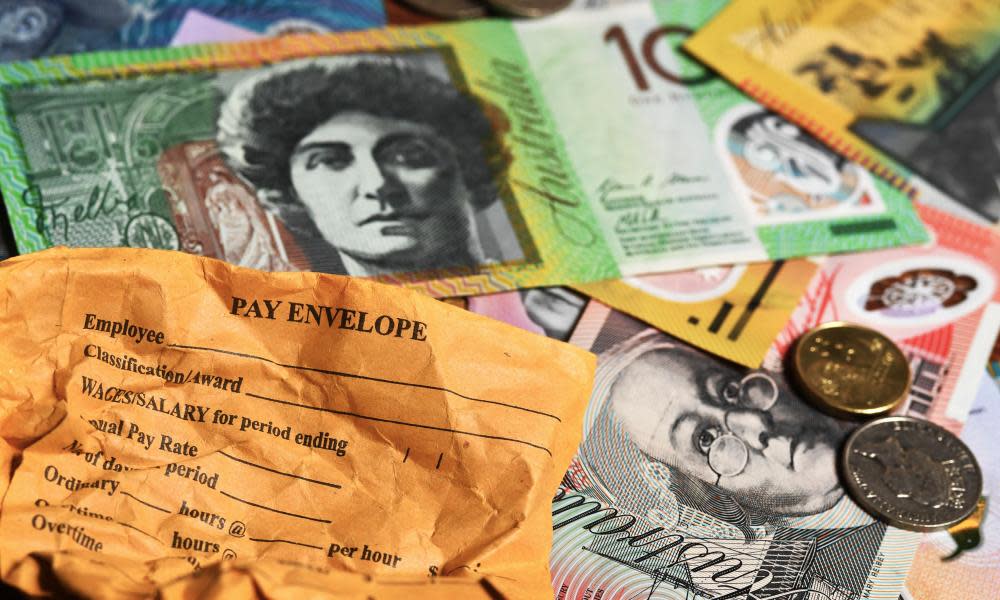Bleak outlook for pay rises: Australians might have to wait five years for return to 2% wage growth

Australian workers could be waiting up to five years for wage growth to return to 2%, a respected economic forecaster has said.
Deloitte Access Economics included the bleak outlook for pay rises in a new report that otherwise paints a bright picture for the Australian economy, assuming the country keeps Covid-19 case numbers low and vaccines come online from February.
Labor said the report showed why the Morrison government “should not and cannot declare victory while more than 2 million Australians are either without a job or don’t have enough hours and wages are stagnant”.
Deloitte’s quarterly business outlook, published on Monday, said wage growth was yet to recover to the rates experienced prior to the global financial crisis, which occurred more than a decade ago, of over 4% a year.
“Those days are gone, and wage growth weakness has been a long-lasting phenomenon both globally and locally,” the report said.
“Measured using the wage price index, wage gains were only a little over 2% when Covid hit, and we forecast they’ll only return to that relatively sluggish rate by late 2025 or early 2026.”
The report said the Covid crisis would also keep inflation “bumping along the bottom for some time”. Inflation may not hit “rock bottom” until mid-2022.
“Even allowing for the improved recovery prospects accompanying the good news on vaccines, underlying inflation may not get back into the Reserve Bank’s comfort zone of between 2 and 3% until late 2023 or early 2024.”
On the bigger picture, the report said Australia was one of the few places – alongside China, Taiwan, Vietnam and New Zealand – to enter 2021 “very well-placed”.
It cited low Covid-19 numbers, positive news on the vaccine front, rebounding confidence and “heartening developments” in job markets.
Victoria was catching up to the economic recovery under way in other parts of Australia, the report noted.
After the challenges of last year, when Victoria deployed “the hammer” against the second wave of Covid-19 infections, that state is now predicted to be the fastest-growing part of Australia in 2021.
“To be clear, although the damage of 2020 is winding back fast, it definitely hasn’t disappeared, and it will linger: the enormous protection provided by the federal government is being dismantled rapidly, the world economy is a mess, and the geopolitical backdrop for Australia looks more troubled than it has been for many years,” the report said.
Related: The government is using the pandemic to lock in low wages and insecure work | Greg Jericho
“Then again, a bit of perspective is handy. Australia has made many mistakes in juggling Covid, but so far we’ve made fewer mistakes than most of the globe. You’d rather be here than almost anywhere else.”
Labor’s treasury spokesperson, Jim Chalmers, said the recovery would be “patchy and defined by even weaker wages growth, following record low wages growth under the Liberals”.
“While there is a welcome recovery under way in some parts of the economy, Deloitte highlights the substantial challenges of high and persistent unemployment and underemployment, stagnant wages and a further decline in business investment,” Chalmers said.
The treasurer, Josh Frydenberg, said there was “still a long road ahead” in the economic recovery.
But he played down concerns of a fiscal cliff at the end of March, when the jobkeeper wage subsidy is due to finish and the top-up to jobseeker allowances is due to expire.
Frydenberg pointed to “an additional $200bn sitting on household and business balance sheets compared to the start of last year”.
“As Deloitte Access Economics notes, Australia is just one of five nations to enter 2021 ‘very-well placed’, with our economy ‘bouncing back rapidly and outperforming expectations’,” Frydenberg said.
“We’re also encouraged by Deloitte’s predictions of a further drop in unemployment to 6.5% in 2021, a long way from Treasury’s initial estimates of a peak of 15% in unemployment without the government’s economic support.”

 Yahoo Movies
Yahoo Movies 
